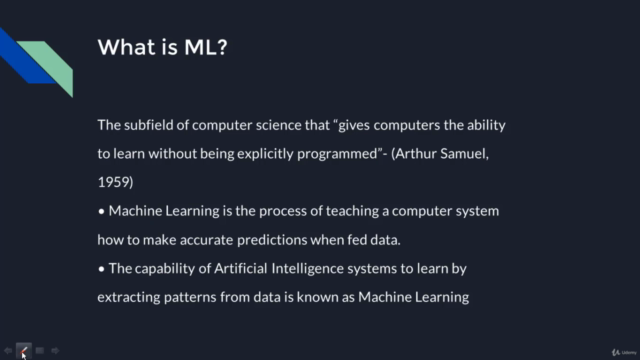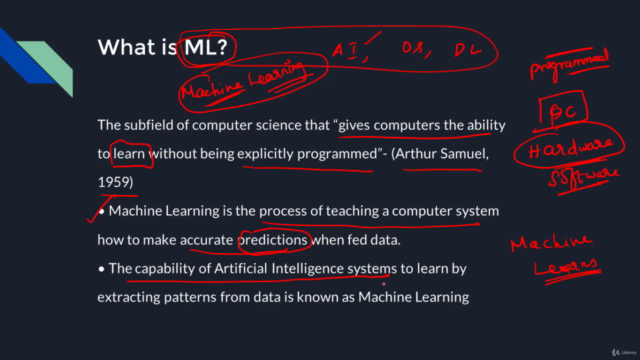Machine Learning using Python Programming

Why take this course?
🌟 Course Headline:
🚀 Dive into Machine Learning with Python! Master the Core Concepts and Algorithms with Practical Implementation in Python 3 📚✨
Course Description:
"Machine Learning is all about how a machine with an artificial intelligence learns like a human being." - Sujithkumar MA
Are you ready to embark on a journey through the fascinating world of Machine Learning (ML)? Our comprehensive online course, "Machine Learning using Python Programming," is designed to take you from the basics to mastery of ML algorithms, all within the versatile and powerful context of Python 3. 🐍
Why Take This Course?
-
Core Concepts Explained: Understand the foundational concepts such as machine learning features, data preprocessing, model fine-tuning, overfitting/underfitting, bias, variance, and the role of a confusion matrix in evaluating model performance. 📈
-
Data Preparation Techniques: Get hands-on experience with preprocessing methods like Binarization, MinMaxScaler, and Standard Scaler that are crucial for training effective models. 📊
-
Mathematics and Concepts First: Before jumping into code, we'll delve into the mathematics and concepts behind each ML algorithm to ensure a deep understanding of how they work. 🧮
-
Python Implementation with scikit-learn: Learn to implement various ML algorithms using Python and the widely-used scikit-learn library, making the learning process both efficient and effective. 🛠️
-
Visual Learning: We'll visualize the ML algorithms in action to make complex concepts accessible and interesting. 🎨
Algorithms Covered:
- 📈 Linear Regression: A fundamental algorithm for predictive modeling.
- 🔮 Logistic Regression: Used for binary classification problems.
- ⚙️ Support Vector Machines (SVM): Effective in classifying data points in a high-dimensional space.
- 🌟 KNN Classifier & KNN Regressor: Versatile algorithms that find the nearest neighbors and use them to predict outcomes.
- 🎲 Decision Tree Classifier: A tree structure where each node represents a feature, each branch represents a decision rule, and each leaf represents an outcome.
- 🌳 Random Forest Classifier: An ensemble of decision trees, often more accurate and less prone to overfitting.
- 🧠 Naive Bayes' Classifier: A family of simple probabilistic classifiers based on applying Bayes' theorem with strong independence assumptions between the features.
- 📐 Clustering (and more!): Explore clustering algorithms that find patterns in data and group similar data points together.
Course Outline:
- Understanding Machine Learning: The importance, misconceptions, and real-world applications of ML.
- Preprocessing Data: Techniques to prepare data for ML models, including Binarization and Scaling.
- Core ML Concepts: Overfitting, Underfitting, Bias, Variance, and more!
- Performance Measures: Metrics such as accuracy, precision, recall, and the F1 score.
- Mathematics Behind Algorithms: A deep dive into the math that powers each algorithm.
- Python Implementation with scikit-learn: Coding examples to implement algorithms from scratch.
- Visualization of ML Concepts: Graphical representations to demystify complex concepts.
- Comparing Algorithm Results: Learn how to choose the right algorithm for your problem.
Who Should Take This Course?
- Aspiring Data Scientists and Analysts
- Python Programmers interested in ML applications
- Anyone curious about understanding and implementing ML algorithms from scratch
- Students and Professionals looking to enhance their technical skill set with practical ML knowledge 🎓
Don't miss out on the opportunity to transform your programming skills into machine learning expertise. Enroll now and start your journey in the exciting field of Machine Learning with Python! 🚀💻
Course Gallery




Loading charts...